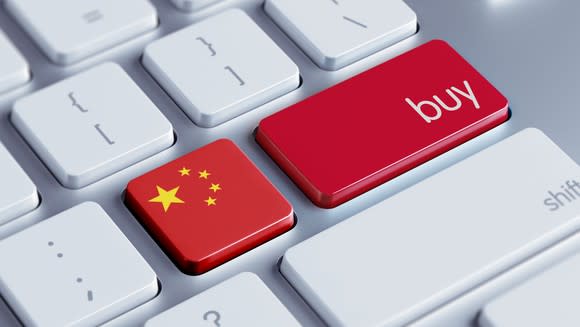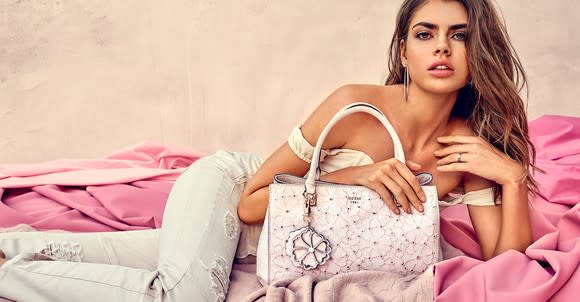These 3 Recovering Retailers Have 1 Thing in Common
Several apparel retailers recently disproved the bears who believed that sluggish mall traffic, e-tailers, and fast-fashion players would bury older clothing stores. That list of winners includes Abercrombie & Fitch (NYSE: ANF), Guess (NYSE: GES), and Ralph Lauren (NYSE: RL), which rallied 81%, 116%, and 106%, respectively, over the past 12 months.
All three brands were once considered also-rans. A&F was rudderless after the resignation of its divisive CEO, Mike Jeffries, who was responsible for "sexing up" A&F and alienating teen shoppers with his infamous "cool kids" comments. Guess faced ongoing sales declines in North America, while Ralph Lauren's turnaround CEO, Stefan Larsson, resigned after clashing with the company's namesake founder.

Image source: A&F.
Yet all three companies eventually got their acts together. A&F's new CEO, Fran Horowitz, launched fresh marketing campaigns, leaned more heavily on Hollister's growth, and renovated the company's Jefferies-era stores. Guess' expansion into Asia and Europe paid off, as its overseas growth offset the softness of the company's North American market. Ralph Lauren, who hired former P&G exec Patrick Louvet as its CEO last year, saw its North American numbers stabilize as its Asian revenues rose.
Each of these retailers improved their businesses in different ways. However, they all enlisted the help of one company -- Chinese e-commerce giant Alibaba (NYSE: BABA) -- to boost their sales in Asia.
Why Alibaba matters
Alibaba's Tmall is China's largest business-to-consumer (B2C) marketplace. It controlled over half the market last year, according to Analysys International Enfodesk, making it an ideal partner for American retailers in China.

Image source: Getty Images.
The total number of online shoppers in China rose from 466 million in 2016 to 533 million in 2017. Goldman Sachs expects that figure to hit about 660 million by 2020, and for China's entire online retail market to grow from $750 billion to $1.7 trillion between 2016 and 2020. Meanwhile, rising income levels will boost demand for overseas brands -- particularly middle-class apparel brands like A&F, Guess, and Ralph Lauren.
Tmall allows companies to set up their own stores within its marketplace. That's a simpler and cheaper approach than establishing and expanding first-party e-commerce platforms across China.
How these retailers are working with Alibaba
Speaking to Alibaba's news hub Alizila, Abercrombie & Fitch's Horowitz stated that its namesake brand was "strong in China" and that its partnership with Tmall gave the brand an "opportunity to bring A&F to even more consumers." Horowitz noted that "with 75 percent of Alibaba Group's consumers under the age of 35, and about 80 percent of transactions taking place on mobile, the demographics on Alibaba's platforms align well with our updated A&F brand's target consumer in their twenties."
Last quarter, Horowitz attributed the turnaround in Abercrombie's namesake brand -- which broke a multi-year streak of comps declines with 5% growth -- to its "great success" on Tmall. That growth easily offset the brand's less impressive growth in other markets.

Image source: Guess.
Guess CEO Victor Herrero made similar comments last quarter, claiming that the company's "marketplace partnership with Tmall continues to grow at such terrific speed" that it could become "as big as" its US e-commerce business within a "few years." Guess' Tmall partnership was a major contributor to its whopping 40% year-over-year sales growth (33% on a constant currency basis) in Asia during the quarter.
Ralph Lauren posted 17% sales growth (11% on a constant currency basis) in Asia last quarter, with the region's 4% comps growth marking an acceleration from its previous quarters.
Within that total, the company posted 34% growth in mainland China on a constant currency basis, and 22% growth across the Greater China region. During the conference call, Louvet stated that growth was enhanced by its "strong digital expansion in China on Tmall, JD.com, and WeChat."
The bottom line
A&F, Guess, and Ralph Lauren aren't the only American retailers that have partnered with Tmall, but their growth figures indicate that Alibaba is a great ally for boosting Asian revenues. If you're invested in other struggling apparel retailers, check if they've partnered with Tmall or other Chinese tech players to maximize their overseas growth.
More From The Motley Fool
Leo Sun owns shares of JD.com. The Motley Fool owns shares of and recommends JD.com. The Motley Fool has a disclosure policy.

 Yahoo Finance
Yahoo Finance 